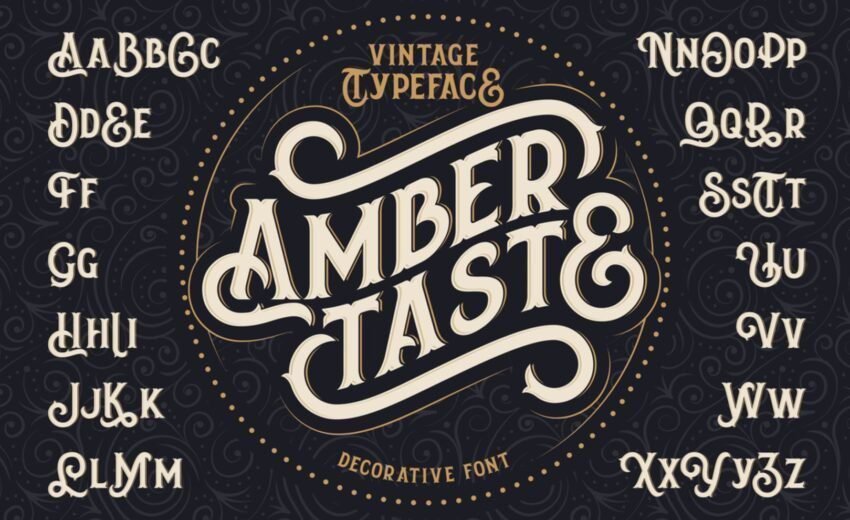
In Typographic Art Revolution: Language and Design Fusion, we will be taken through the far-reaching effects of typography art on visual communications. Typography art is the confluence of language and design; it has morphed from a mere functional printing element to an influential aesthetic medium. This blog post looks at the history and development of typography art, which changed from type-setting traditionally to becoming dynamic artwork that defies all conventional standards. The beautiful curves of serif letters juxtaposed with sans-serif styles that make bold statements are just some examples of typesetting designs that captivate audiences due to their ability to communicate meaning, feeling, and personality through lettering arrangement.
Throughout this discussion, we reveal how typographic art relates intricately with the practice of contemporary designing. Technology keeps opening up new pathways for creativity as well as innovation for typographers. We shall see how digital tools have played a key role in driving the change in typography art by availing design resources to all interested designers, thus democratizing access to these resources while at the same time enabling artists to push limits in terms of typographical experimentation. From full-scale digital installations to interactive online ones.
Table of Contents
Introduction


Typography artwork is the harmonious marriage of letters, words, and layouts. It’s not just about selecting a font; it’s approximately respiration lifestyles into the one’s characters. Here’s a glimpse of what typography artwork includes:
- Letterforms as Canvas: Imagine every letter as a tiny canvas ready to be adorned. Typography artists meticulously tweak curves, serifs, and spacing to create visually charming compositions.
- Expressive Fonts: From elegant serifs to playful scripts, typography gives a considerable font palette. Each typeface includes its persona, evoking emotions and setting the tone for the communique.
- Beyond Words: Typography transcends mere communication; it will become an artwork form. Think of iconic logos, e-book covers, or film posters—their typography choices leave lasting impressions.
The Importance of Typography in Design
Typography isn’t pretty much aesthetics; it’s an effective tool that influences how we understand facts. Here’s why it matters:
- Visual Hierarchy: Typography publications our eyes. Bold headlines draw attention, even as subtle body text invites us to read further. It’s like a nicely choreographed dance where fonts lead the manner.
- Branding Identity: Companies carefully pick out fonts to represent their brand. Coca-Cola’s curvy script exudes warmth, even as IBM’s glossy sans-serif radiates professionalism.
- Legibility and Readability: Have you ever struggled to decipher poorly selected fonts? Legible typography guarantees smooth reading, whether it’s a unique or a street signal.
- Emotional Impact: Typography can evoke feelings—serene serifs, quirky scripts, or futuristic sans-serifs carry awesome emotions.
Exploring the Transformative Impact
Let’s dive into our thesis: How does typography artwork transform visual communication?
- Storytelling: Typography isn’t just about letters; it’s approximately storytelling. The proper font can transport us to exceptional eras, cultures, or moods. Imagine a vintage film poster with weathered serif fonts—it right away whispers tales of nostalgia.
- Cultural Context: Typography reflects cultural nuances. Arabic calligraphy, Chinese brush strokes, and Gothic lettering convey wealthy histories and meanings. They bridge gaps and join us globally.
- Digital Revolution: In our digital age, typography adapts. Web fonts, responsive designs, and cellular-friendly typefaces ensure seamless verbal exchange across displays.
- Subliminal Messages: Subtle font alternatives convey hidden messages. A formidable sans-serif screams self-assurance, whilst a delicate script whispers intimacy.
- Artistic Fusion: Typography blends with different design factors—colors, photographs, and layouts. It’s the glue that binds visible communique collectively.
Typography art isn’t just about arranging letters; it’s approximately orchestrating feelings, narratives, and connections. So the next time you spot a superbly designed poster or an elegantly crafted internet site, bear in mind: that typography is the unsung hero behind the scenes, shaping our visual international.
Evolution of Typography Art


Certainly! Let’s explore the captivating journey of typography art, from ancient chiseled letters to the digital age. Buckle up, fellow font enthusiasts—we’re about to dive into the world of typefaces, serifs, and kerning!
Historical Roots and Development of Typography
Typography isn’t an insignificant invention of the current age; it has roots that extend again via the annals of time. Here’s a glimpse of its captivating evolution:
- Ancient Carvings and Seals: Millennia ago, our ancestors etched symbols into clay drugs and stone surfaces. Think Sumerian cuneiform and Egyptian hieroglyphics—early typography in its raw shape.
- Roman Square Capitals: Enter ancient Rome, in which chiseled Roman rectangular capitals ruled the scene. These majestic letters decorated monuments, inscriptions, and reputable files. Imagine the Colosseum shouting, “Hey, take a look at my series!”
- Medieval Manuscripts: As Europe scribbled its way through the Middle Ages, we witnessed the delivery of Blackletter. Picture priests hunched over manuscripts, meticulously crafting angular, heavy letters. Gothic vibes, each person?
- Gutenberg’s Printing Press: In 1450, Johannes Gutenberg unleashed the printing press, and typography danced into the spotlight. Move over, quills—steel movable type changed into here to stay. The Renaissance rejoiced!
The Emergence of Typography as an Art Form
Typography shed its purposeful cloak and donned an inventive gown. Here’s the way it blossomed:
- Renaissance Revival: During the Renaissance, typography became greater than a trifling conversation device. It transformed into an artwork form. Designers and printers experimented with typefaces, sizes, and layouts. Suddenly, letters waltzed across pages like elegant ballroom dancers.
- Roman Type Rebirth: Renaissance artists seemed lower back to historical Rome for the suggestion. They revived Roman typefaces—the ones with noble, balanced letters. The result? A harmonious combo of subculture and innovation.
- Venetian Serifs: Venice, the metropolis of canals and intrigue, birthed a brand new typeface: Venetian Serifs. These curvaceous, swish letters graced early printed books. Imagine gondolas floating alongside italicized verses.
Key Milestones in Typography Art’s Evolution
Fasten your seatbelts; we’re zooming through time:
- Carolingian Minuscule: Charlemagne, the medieval trendsetter, standardized Carolingian minuscule—a lowercase script. It turned into just like the Helvetica of its day—clean, legible, and suited for scholarly tomes.
- Gothic to Antiqua: Gothic blackletter dominated Germany, however, Italy craved something greater Humanist. Enter Antiqua—a typeface that whispered Cicero’s information. It becomes like swapping medieval armor for a tailor-made suit.
- Digital Revolution: The overdue ’70s and early ’80s noticed a seismic shift. Digital typefaces pirouetted onto displays. Helvetica, Times New Roman, and Arial took the middle stage. The pixelated dance ground became set.
- Bauhaus and Decorative Fonts: The Bauhaus motion added geometric fonts—clean strains, minimum fuss. Meanwhile, ornamental fonts twirled with aptitude—Art Nouveau, Art Deco, and psychedelic vibes.
Typography art isn’t just about arranging letters; it’s approximately orchestrating emotions, narratives, and connections. So next time you notice a fantastically designed poster or a meticulously crafted e-book cowl, tip your hat to the unsung heroes—the typefaces that breathe existence into our visible world.
The Language of Typography


Certainly! Let’s unravel the captivating language of typography art—where letters dance, fonts whisper, and spacing sings. Buckle up, fellow font enthusiasts; we’re about to explore how typography communicates beyond mere words.
Understanding Typography as a Language
Imagine typography as a language—a silent conversation etched onto paper, screens, and billboards. Here’s the lowdown:
- Vocabulary: Fonts are our alphabet. Each typeface carries its personality. Think of Helvetica as the friendly neighbor, Gothic as the mysterious stranger, and Script as the romantic poet.
- Grammar: Kerning (the space between letters) and leading (line spacing) form our grammar. Tight kerning shouts urgency, while generous leading invites leisurely reading.
- Syntax: Arrangement matters. Headlines scream in bold, subheadings whisper, and body text flows like a gentle stream.
- Punctuation: Think of serifs (those little feet on letters) as commas—subtle pauses. Sans-serifs? They’re the exclamation marks—bold and assertive.
Typography Beyond Words
Now, let’s dive deeper. Typography isn’t just about legibility; it’s a silent orchestra playing emotions, tone, and style:
- Emotion: Fonts wear their hearts on their curves. A delicate script whispers romance, while a rugged slab-serif exudes strength. Imagine a wedding invitation in Gothic—it’d be like proposing in a haunted castle!
- Tone: Typography sets the mood. Formal? Choose a classic serif. Playful? Go for a bubbly sans-serif. Imagine a legal contract in Comic Sans—it’d be like wearing flip-flops to a boardroom meeting.
- Style: Fonts define aesthetics. Art Deco screams glamour, while grunge fonts rebel. Picture a vintage café menu in Art Nouveau—it’d be like sipping espresso with Monet.
Examples of Typography in Action
Let’s peek at real-world magic:
- Nike’s Swoosh: That iconic swoosh isn’t just a tick; it’s a heartbeat. The sleek sans-serif whispers speed, movement, and victory.
- New York Times Headlines: Bold, authoritative serifs command attention. They say, “Stop scrolling; this is news!”
- Coca-Cola Script: Those curvy letters evoke nostalgia, fizz, and shared moments. It’s like sipping memories from a glass bottle.
- Gotham in Obama’s Campaign: Obama’s “Hope” posters rocked Gotham—a modern, inclusive sans-serif. It said, “Change is coming.”
, typography isn’t just ink on paper; it’s a symphony of expression. Next time you read a sign, a book, or a meme, listen closely—the language of typography is speaking to you.
The Design Element in Typography Art


Certainly! Let’s dive into the captivating international typography artwork and discover the way it seamlessly blends design standards, aesthetics, and capability. Typography isn’t pretty much arranging letters; it’s a symphony of visible verbal exchange. So, grab your favorite font, and let’s discover!
Incorporating Design Principles into Typography Art
Typography isn’t a solo act—it dances with other design elements. Here’s how artists weave magic:
- Hierarchy: Like a conductor leading an orchestra, typography establishes hierarchy. Headlines shout subheadings whisper, and body text flows. It’s about guiding the viewer’s eye.
- Consistency: Typography should be as reliable as your morning coffee. Consistent fonts, sizes, and spacing create harmony. Imagine a symphony where every instrument plays in tune.
- Contrast: Typography loves drama. Bold against light, serif against sans-serif—it’s the yin and yang of design. Contrast creates visual tension and keeps the eyes engaged.
- Whitespace: Ah, the elegant pause between notes! Whitespace (or negative space) gives typography room to breathe. It’s like leaving space for a solo violinist to shine.
- Alignment: Think of it as choreography. Left-aligned, centered, or justified—each choice sets a mood. Imagine a ballet where dancers move in perfect sync.
Balancing Aesthetics and Functionality
Typography artwork isn’t pretty much pretty letters; it’s about reason. Here’s the delicate balancing act:
- Legibility: No one enjoys deciphering cryptic fonts. Legibility is non-negotiable. Choose typefaces that play nice with readers’ eyes. Remember, even avant-garde artwork needs to be readable.
- Emotional Tone: Fonts have vibes. A playful script says, “Let’s dance!” A stoic serif whispers, “Formal business.” Match the mood to the message.
- Brand Identity: Brands put on typography like a tailor-made suit. Coca-Cola’s script is as iconic as its crimson label. Your font choice speaks volumes about your emblem’s personality.
- Functionality: Typography isn’t only for posters; it’s anywhere—trademarks, websites, packaging. Consider scalability, responsiveness, and adaptability. Will your font behave on a tiny app icon? Will it dazzle on a billboard?
Typography art isn’t pretty much letters; it’s a language of layout. So next time you spot a beautifully crafted emblem or a mesmerizing e-book cowl, keep in mind—the typeface whispers secrets, and the layout dances to its tune.
Technology and Typography Art


Certainly! Let’s explore the fascinating intersection of technology and typography art. Typography isn’t just about arranging letters; it’s a dance between creativity and digital innovation. So, grab your favorite font, and let’s dive in!
Impact of Digital Tools on Typography Art
Our virtual age has revolutionized how we wield typefaces. Here’s how technology waltzes with typography:
- Vector-Based Software: Imagine a typographer’s dream—a software program like Adobe Illustrator. It’s like having a magic wand for scalable fonts. Designers can create typography that dances gracefully throughout monitors, from tiny cell shows to grand computing device video display units.
- Digital Typefaces: The font library has exploded! Thanks to digital typefaces, we’re no longer limited to Times New Roman or Arial. Now, we can pick out from a substantial array of patterns—serifs, sans-serifs, scripts, and quirky show fonts. It’s like having a font buffet at our fingertips.
- Responsive Design: Typography adapts like a chameleon. With a responsive layout, textual content elegantly adjusts to exceptional screen sizes. Whether you’re analyzing on a phone in the course of lunch or on a widescreen reveal at your desk, the text remains legible and exquisite.
Accessibility and Democratization of Typography Art through Technology
Technology isn’t just for the elite—it’s for everybody. Typography art isn’t an exception. Here’s the way it’s becoming more inclusive:
- Breaking Barriers: Historically, art creation required specialized gear and education. But now, with only a laptop and an internet connection, all people can explore their artistic talents. Typography equipment is like open doors, inviting people from various backgrounds to take part.
- Affordability: Gone are the times of costly printing presses. Digital tools democratize typography making it low-priced. Artists can experiment, iterate, and create without breaking the bank. It’s like having a digital art studio in your pocket.
- Inclusivity: Typography embraces all voices. Whether you’re in a bustling town or a far-flung village, generation ensures that your creative expression is heard. It’s like an international typographic symphony, where every font subject.
Future Trends in Technology-Driven Typography Art
Fasten your seatbelts; destiny holds thrilling possibilities:
- Serif Renaissance: Serif fonts are coming around again. Their undying elegance and readability have designers swooning. Imagine a world where serifs rule—like a vintage film poster whispering secrets and techniques.
- Dynamic Typography: Brace yourself for animated type! In 2024, typography will dance, wiggle, and morph. Think 3-D effects, responsive letterforms, and interactive fonts. It’s like typography doing the cha-cha with era.
- AI-Powered Creativity: Artificial intelligence (AI) might be our muse. Machine mastering algorithms will analyze statistics, understand styles, and generate novel fonts. Picture an AI-generated typeface that captures feelings—like a font with a coronary heart.
- Hybrid Art: Artists won’t worry about AI; they’ll include it. Imagine a canvas in which human brushstrokes mix seamlessly with AI-generated factors. It’s like a duet among creativity and algorithms.
Technology isn’t sidelining typography art; it’s giving it wings. So, whether you’re a seasoned typographer or a curious novice, hold your eyes at the horizon—the future of typography is wonderful.
Typography Art in Contemporary Culture


Certainly! Let’s explore the captivating role of typography art in contemporary culture. From billboards to Instagram feeds, from gallery walls to brand logos, typography is everywhere, shaping our visual experiences. So, grab your favorite font, and let’s dive into this fascinating world!
Influence of Typography Art in Advertising, Branding, and Social Media
Typography isn’t just about letters; it’s a silent storyteller. Here’s how it leaves its mark:
- Billboards and Beyond: Picture yourself driving down a busy highway. Those massive billboards? Typography’s playground. Bold sans-serifs scream “SALE!” while elegant serifs whisper “Luxury awaits.” It’s like a typographic tug-of-war for your attention.
- Brand Identity: Logos are the face of brands. Think of Apple’s sleek, minimalist font—it’s as iconic as the bitten apple itself. Typography defines brand personality. Coca-Cola’s cursive script? Instant nostalgia. Google’s playful sans-serif? Approachable innovation.
- Social Media Aesthetics: Scroll through Instagram. Typography art is the secret sauce. Influencers use custom fonts to stand out. Memes? Typography’s witty one-liners. Hashtags? Typography’s way of saying, “Join the conversation!”
Typography Art in Fine Art and Graphic Design
Typography transcends mere communication; it becomes art. Here’s how it paints outside the lines:
- Fine Art Expressions: Artists wield typefaces like brushes. Imagine a canvas splashed with bold letters, forming abstract shapes. Typography art isn’t just readable; it’s emotive. It’s like poetry for the eyes.
- Calligraphy and Lettering: Calligraphers are modern scribes. Their ink dances on paper, creating intricate letterforms. It’s like music notes—each stroke carries rhythm and emotion. Lettering artists? They craft custom fonts, turning words into visual melodies.
- Graphic Design Wizardry: Graphic designers orchestrate layouts. Typography is their symphony. They balance fonts, whitespace, and hierarchy. Imagine a magazine spread—the headline shouts, the body text whispers. It’s like a typographic dance floor.
Examples of Typography Art Shaping Cultural Narratives and Movements
Typography isn’t neutral; it’s a cultural force. Here are some powerful examples:
- Black Lives Matter: Those three words—bold, impactful, urgent. Typography art fuels social justice movements. Protest signs, Instagram posts, murals—all carry messages that echo through history.
- Punk Rock Rebellion: The Sex Pistols’ ransom-note typography screamed anarchy. It challenged norms and shook institutions. Typography became punk’s battle cry—a visual rebellion.
- Feminist Manifestos: From “The Future is Female” to “Nevertheless, She Persisted,” typography art amplifies feminist voices. It’s not just words; it’s empowerment.
- Political Campaigns: Obama’s “Hope” poster? That iconic font spoke of change, unity, and possibility. Typography shapes political narratives, rallying hearts and minds.
Typography art isn’t confined to fonts; it’s a cultural chameleon. Next time you see a logo, a protest sign, or a gallery exhibit, remember—the letters aren’t silent; they’re shouting stories.
Challenges and Opportunities


Certainly! Let’s explore the fascinating world of typography art, where letters dance, fonts sing, and creativity knows no bounds. Typography artists are both poets and architects, shaping words into visual symphonies. So, grab your favorite typeface, and let’s dive into the challenges and opportunities awaiting these artistic maestros.
Common Challenges Faced by Typography Artists
Typography isn’t all rainbows and unicorns; it comes with its percentage of hurdles:
- Font Overload: The font library is widespread—like a never-ending buffet. Choosing the proper typeface can seem overwhelming. Serif or sans-serif? Bold or light? Each choice topics.
- Legibility vs. Aesthetics: Balancing clarity with creative flair is like tightrope strolling. Fancy scripts may additionally look fantastic, however, if readers squint, you’ve lost them. Finding that candy spot is an artwork in itself.
- Client Expectations: Clients often have unique font preferences. They might say, “Make it pop!” or “Evoke beauty.” Deciphering their cryptic requests may be tough.
- Taming the Kerning Beast: Adjusting letter spacing (kerning) is like herding cats. Too tight, and it’s claustrophobic; too loose, and it’s chaotic. Achieving that Goldilocks stability takes exercise.
Opportunities for Innovation and Experimentation
Typography artists aren’t sure by way of regulations; they’re pioneers. Here’s where the magic occurs:
- Custom Typefaces: Why accept off-the-shelf fonts? Designers can create bespoke typefaces tailored to an emblem’s persona. Imagine a brand with a signature font—precise and unforgettable.
- Variable Fonts: These chameleons adapt on the fly. Imagine a font that morphs from thin to bold, slim to wide, all within an unmarried file. It’s like having a font with temper swings.
- Responsive Typography: Websites aren’t static; they breathe. Responsive typography adjusts seamlessly throughout gadgets. Mobile, tablet, computer—the font dances to the screen length.
- Experimental Layouts: Break free from the grid. The text doesn’t usually need to march in immediate traces. Imagine words swirling around pics, zigzagging, or forming shapes. It’s like choreographing a typographic ballet.
Strategies for Overcoming Obstacles and Pushing Creative Boundaries
Typography artists fear not! Here are your secret weapons:
- Type Anatomy Study: Dive deep into serifs, ligatures, and descenders. Understand the bones of typefaces. It’s like knowing the anatomy before you sculpt.
- Sketch, Sketch, Sketch: Grab a pencil and paper. Sketch type variations. Play with curves, angles, and flourishes. It’s like a warm-up before the typographic marathon.
- Critique and Iterate: Show your work to fellow artists. Feedback is gold. Revise, refine, repeat. It’s like chiseling a statue until it gleams.
- Break the Grid: Typography isn’t confined to boxes. Let letters spill, overlap, or break free. It’s like letting wild horses roam.
typography artists, you’re the architects of language. Embrace challenges, seize opportunities, and let your fonts sing symphonies that echo through time.
Conclusion


Certainly! Let’s wrap up our typographic journey with a flourish—a grand finale where letters take their final bow.
- Language Whisperer: Typography speaks without words. It guides our eyes, sets moods, and sparks emotions. From billboards to book covers, it’s the silent narrator.
- Brand Alchemist: Logos, packaging, websites—brands wear typography like tailored suits. Coca-Cola’s script? Instant recognition. Google’s sans-serif? Approachable innovation. Typography shapes brand identities.
- Cultural Time Traveler: Typography carries history. Gothic blackletter whispers medieval tales. Art Deco fonts scream Roaring Twenties. It’s like a time machine fueled by ink.
- Font Safari: Wander through the font jungle. Explore type libraries. Try serifs, sans-serifs, scripts, and display fonts. It’s like tasting exotic dishes—each font has a flavor.
- Observe Everywhere: Look around. Billboards, menus, movie posters—they’re all typographic canvases. Decode their messages. It’s like being a secret agent deciphering clues.
- Create Your Font: Grab a pen and doodle letters. Craft your typeface. It’s like planting seeds; watch them grow into fonts.
FAQs


Typography art isn’t confined to fonts; it’s a cultural chameleon. Next time you see a logo, a protest sign, or a gallery exhibit, remember—the letters aren’t silent; they’re singing.
Certainly! Let’s address some frequently asked questions (FAQs) about typography art:
What is typography art?
Typography art is the creative arrangement and design of letters, words, and symbols. It goes beyond mere communication; it’s about shaping emotions, aesthetics, and narratives through fonts.
Why is typography important in design?
Typography sets the tone, hierarchy, and readability of visual content. It guides our eyes, evokes emotions, and defines brand identities. Whether it’s a book cover, a website, or a logo, typography matters.
How do I choose the right font?
Consider the context: Is it for a formal invitation or a playful poster?
Match the mood: Serifs for elegance, sans-serifs for modernity, scripts for romance.
Test readability: Ensure it’s legible across different sizes and screens.
Can I create my font?
Absolutely! Sketch letters, refine them, and digitize them using software like Adobe Illustrator or Glyphs. Custom fonts add uniqueness to your projects.
What’s the future of typography art?
Variable fonts, responsive typography, and AI-generated typefaces are on the horizon. Typography will continue to adapt, innovate, and shape our visual experiences.
Remember, typography isn’t just about letters; it’s a language of creativity. Explore, experiment, and let your fonts sing!
🌐 Connect with us:
Youtube: https://www.youtube.com/@hubtechpk
Facebook: https://web.facebook.com/hubtechpk/
Instagram: https://www.instagram.com/hubtechpk
Twitter: https://www.twitter.com/hubtechpk
Tiktok: https://www.tiktok.com/@hubtechpk






ai Automation Agency March 6, 2024
Howdy! I just want to offer you a huge thumbs up
for your excellent information you have right here on this
post. I am coming back to your web site for more soon.